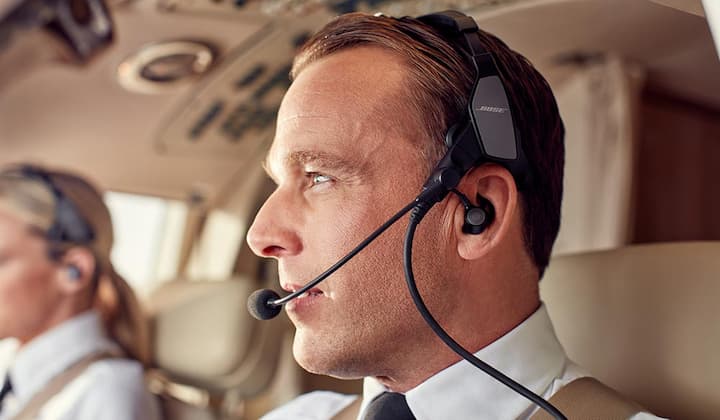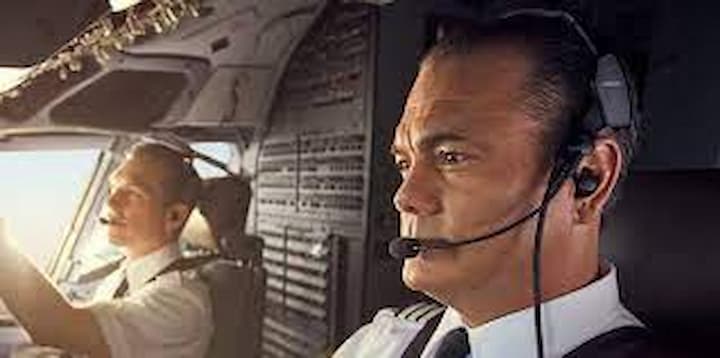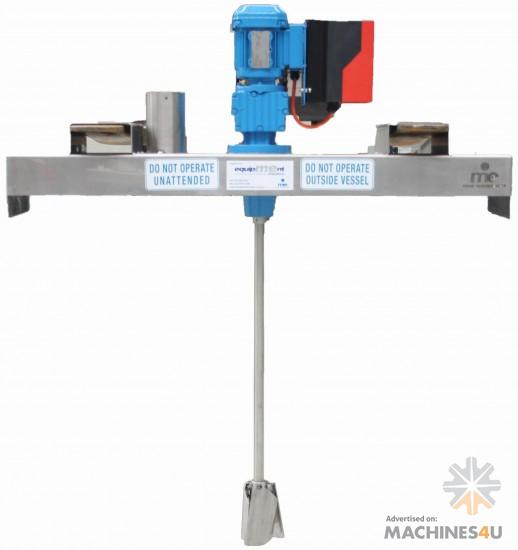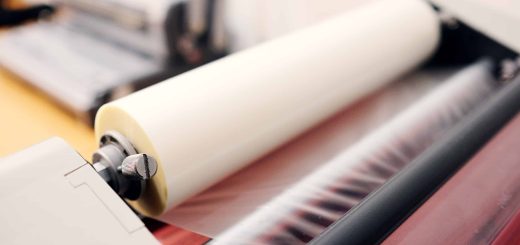A Guide to Aviation Headsets
If you’re a pilot, then you know the peace of mind that comes from being able to fly with your own high-quality headset. No one likes loaners, especially for long periods on noisy flight decks, and having a comfortable pair of your own that has all the audio properties you trust is worth its weight in gold.
You expect your headset to have a superior sound quality and optimum noise reduction without feeling like they’re holding your head in a vase. And suppose you regularly move between different types of aircraft, or between fixed-wing and helicopters. In that case, you want to know that all you’ll need is an adapter to plug your headset in anywhere without compromising audio integrity.
Bose Corporation introduced its first commercially available active noise reduction (ANR) headset, the Series 1, to the aviation industry in 1989; in the process, it set the standard for unsurpassed quality and reliability in aviation headsets.
Today, lightweight, customizable Bose headsets are the benchmark that all other aviation headsets are measured by. And with a range of Series 1-inspired headsets that are engineered for all kinds of flight deck and cockpit environments, you can be sure that Bose can give you all the peace of mind you need for even the toughest conditions.

Unrivalled Aviation Headset Innovation from Bose
Although the variety of panel-mounted and handheld radios, transceivers, and intercoms continues to grow, headset requirements have barely changed. Reduced cockpit noise and clearer comms are still at the heart of everything, and ProFlight Series 2 and A20 Bose aviation headsets are the most advanced noise cancellation and clear vocal technology headsets available for any type of commercial, civilian, or military aircraft use.
These FAA TSO (Technical Standard Order) and EASA (European) E/TSO-C139 and -C139A certified headsets combine Bose’s legendary performance with all the necessary features required for either high or low noise settings, but it’s their unrivalled commitment to flexibility and innovation that gives them the advantage. They’re the characteristics that pilots value the most, and they’re also the characteristics that set every model of Bose aircraft headset apart from its contemporaries.
Maximized Bose Headset Configuration
While the Series 2 and A20 models are designed for two distinctly different operating environments, what these top-of-the-line Bose headsets offer in common is their range of configuration. Either model can be ordered with the full range of standard aviation connections, including:
- Dual GA (General Aviation) connectors consisting of a PJ-055 earphone and PJ-068 microphone plug;
- XLR 5- and 7-pin standard plugs for Airbus, ATR, and a growing number of Boeing aircraft;
- LEMO 6-pin barrel “Bose” connectors for fixed-wing aircraft and helicopters;
- U-174 single cord connection for earphones and microphone for fixed-wing aircraft and helicopters; and,
- Fischer 8-pin connector for Agusta Helicopters.
A complete selection of Bose headset adapters allow for added connection flexibility when you’re moving between aircraft; and either Bose model can be ordered with optional Bluetooth connectivity, making them ideal for wirelessly connecting to portable devices.
Regardless of whether you need battery-powered or aircraft-powered connectivity, maximized Bose solutions cover all the bases. It’s each model’s specifications that make all the difference while you’re flying, though; and Bose’s aviation headset line-up doesn’t disappoint when it comes to communications expectations.
Bose’s Conventional Heavyweight, the A20
It’s no coincidence that piston engine aircraft pilots consider the on-ear, Bose A20 aviation headset to be the best headset of its kind currently on the market. Weighing only 12oz (340gr) and boasting 30% greater active noise reduction than other conventional headsets due to its proprietary ANR system, the A20 is both the lightest and most advanced aviation headset ever created by Bose, and boasts an array of operational features that include:
- Bose Active EQ equalization for crystal clear communications from all sources;
- Auxiliary priority switching for dedicated systems like GPS or TCAS warnings; and,
- Customizable audio prioritization that allows multiple incoming signals to be muted or mixed.
And A20 headsets don’t sacrifice comfort or convenience for the benefit of performance. The A20’s torsion-sprung headband utilizes 30% more clamping force than ordinary headsets, and its specially designed ear cushions help hold the headset securely in position without becoming a hindrance.
The A20’s comfort complement is rounded out with:
- An intuitive, plug-and-play control module that powers up instantly with the aircraft, or with AA batteries;
- Smart shutoff to help provide up to 45 hours of battery life when not powered by the aircraft; and,
- An adjustable microphone that can be mounted to either the left or right ear cushion.
For simple, straightforward performance that allows you to communicate clearer than ever with ATCs, aircrews, and passengers, the Bose A20 headset is the heavyweight of conventional headsets. However, if you need a headset that’s designed especially for commercial aviation, then you don’t need to look any further than the successor to Bose’s first aviation headset: the ProFlight Series 2.

Bose’s Aviation Professional, the Series 2
Weighing in at a barely noticeable 4.9oz (139gr.), the Bose aviation ProFlight Series 2 is an in-ear, ARINC (Aeronautical Radio Inc.) standard commercial headset unlike any other. As the smallest, lightest, and most comfortable headset available for use on low-noise flight decks, the Series 2 builds on all the qualities that helped make the Series 1 popular with commercial and corporate aviators, and adds a host of updated features such as:
- Improved Digital ANR for ambient noise, with three (3) user-selectable modes of noise cancellation;
- Earbud tap control for talk-through communications; and,
- Audio prioritization for muting or mixing flight deck communications signals.
An adjustable headband with rotating side pads and feather-light clamping force helps give the Series 2 stability and prolonged comfort that the Series 1 didn’t have, and its thinner cable makes freedom of movement easier than ever. And for pilots who opt to purchase the Series 2 with Bluetooth connectivity, it can also be integrated with the Bose Connect App for use with electronic flight bags, as well as audio sharing, connection management, pairing and unpairing, and renaming of other portable devices.
Series 2 also add to its list of conveniences with:
- An ergonomic plug-and-play control module that controls all the major operational features of the headset;
- Smart shutoff with up to 45 hours of regular battery life, and 25 hours on wireless; and,
- A quick-release, noise-cancelling microphone that can be switched from left to right.
In short, ProFlight Series 2s are the most advanced Bose aircraft headsets ever for professional flight decks. For long-distance, multi-source communication environments, it’s the perfect headset for pilots who need the most modern features in the lightest possible package.
The Final Word
At the end of the day, as a pilot, your choice of headsets is bound to be a very personal decision. A lot depends on the types of aircraft you fly and the types of comms gear they’re equipped with. However, how well they reduce ambient noise, their vocal clarity, and their level of comfort are the real factors that determine whether their headsets worth having or not.
With a flawless history of reducing flight deck noise, crystalline audio properties, and superior comfort, the quality that goes into Bose aviation headsets is unequalled by any other headset manufacturer serving the aviation industry, and their ProFlight Series 2 and A20 models are the headsets that all others are measured against. In short, you can trust Bose to give you the peace of mind that you need to remain solidly focused on your main priority: flying.









